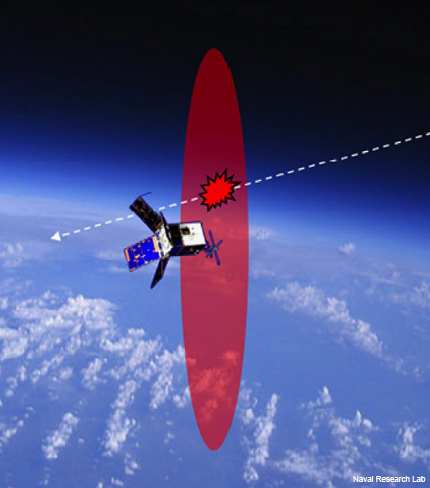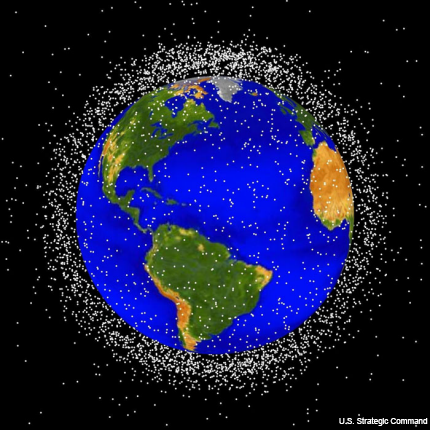NRL patents a small, orbital space junk sensor
The low-power, low-cost Optical Orbital Debris Spotter will allow for greater monitoring of the space debris threatening critical satellite infrastructure.

The light sheet created by the sensor can detect debris as small as 0.01 centimeters.
The Naval Research Lab recently received a patent for it Optical Orbital Debris Spotter, a small low-power and low-cost local space debris detection concept that can help better track the growing amount of debris in space.
Such debris, even smaller than a centimeter, flying at speeds exceeding several miles per second can cause serious damage to critical satellites the military (and civilians) rely on for imaging, communications and navigation.
NRL described in a release that the concept for the orbital debris detection sensor is to create a continuous light sheet by using a collimated light source, such as a low-power laser, and a conic mirror. Any particles, even those as small as 0.01 centimeters, crossing into the permanently illuminated light sheet scatter the light and be detected. The spotter could then gather data about the particles that can be added to modeling software to help increase the understanding of space debris.
"When the flight path of an orbital debris object intersects the light sheet, the object will scatter the light, and a portion of that scattered light can be detected by a wide angle camera," said Dr. Christoph Englert, research physicist at NRL. "The knowledge of the light sheet geometry and the angles of the scattering event with respect to the camera, derived from the signal location on the sensor, allow the determination of the intersection point, and possibly even size, and shape information about the debris particle."
The Joint Space Operations Center, which is responsible for maintaining the Space Surveillance Network, tracks more than 16,000 objects that orbit Earth, of which 5 percent are functioning payloads, 8 percent are rocket bodies and 87 percent are debris and/or inactive satellites. Currently, manmade debris is approaching 100 million objects that can be as small as or smaller than a centimeter. In the already crowded orbital space of Low Earth Orbit – over 1,200 miles above Earth’s surface – debris poses a significant risk to national security.
“Think of what life used to be like and all the things that we have today in warfare that wouldn't exist without space,” Air Force General John Hyten, commander of Air Force Space Command, told 60 Minutes recently. “Remotely piloted aircraft, all-weather precision guided munitions didn't exist before space. Now we can attack any target on the planet, anytime, anywhere, in any weather.”

Low Earth Orbit has the highest concentration of debris, as depicted in this illustration.
The 31 active Global Positioning System satellites the U.S. operates in space not only provide location information and help give directions, they currently are critical for the function of bank ATMs, cellphone towers and power grids, according to 60 Minutes. Damage to these satellites by a pebble-sized piece of debris flying at 17,000 miles per hour could severely cripple military and other capabilities.
NRL’s new technology will enable engender greater space situational awareness at a lower cost. The Optical Orbital Debris Spotter will provide a similar or potentially improved data set of debris for researchers to study and monitor in real-time without the need for the payload to return to Earth.
"Using a dedicated nanosatellite, or CubeSat, the system could also be used for gathering of more comprehensive debris field data," Englert said. "Losing the satellite at some point during the mission by a fatal collision could be considered a justifiable risk in comparison to the odds of getting unprecedented data sets for debris field characterization and modeling."
The new sensor concept weighs a little over 4 pounds and measures roughly 4 inches by 4 inches by 8 inches. NRL said the new data sets created by the spotter could be incorporated into global space tracking tools such as the Space Surveillance Network, NASA’s Orbital Debris Engineering Model and the European Agency’s Optical Ground Station.
In addition to its own efforts at tracking space debris, the Strategic Command also works with eight other countries and two international groups on sharing space situational awareness data.



